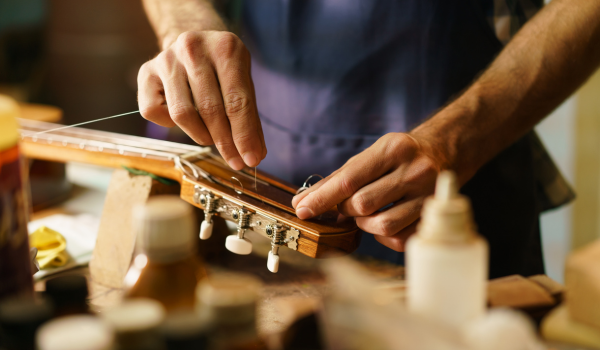
Playing guitar is a journey that begins with mastering the basics, and one crucial skill every guitarist must acquire is how to properly string their guitar. This simple process not only ensures your instrument sounds its best but also teaches you the rudiments of guitar maintenance, including how to fix a guitar string. Aimed especially at those just embarking on their musical odyssey, this guide will arm you with the knowledge and confidence needed to string your guitar correctly and tackle common string issues.
Understanding the significance of proper stringing is key. It enhances the sound quality of your guitar, ensures tuning stability, and extends the life of your strings. It lays the foundation for a fulfilling playing experience, making your practice sessions more effective and your performances captivating.

Essential items include a new set of strings, a string winder (optional but helpful), wire cutters, and a tuner. Having these tools ready beforehand simplifies the task at hand.
Turn the tuning pegs counter-clockwise to loosen and remove the old strings. A string winder can make this step quicker. Use wire cutters to cut the strings for easier removal, but proceed with care to avoid any damage to your guitar.
This is an opportune moment to clean your guitar. Use a soft, dry cloth to wipe down the fretboard, bridge, and headstock. If the fretboard seems dry, a small amount of lemon oil can help rejuvenate it.
Begin with the low E string (the thickest one), threading it through the bridge and then through the corresponding tuning peg, allowing some slack for winding. A useful tip is to leave enough slack for about three hand-widths.
Wrap the string around the tuning peg, under then over the string end, to secure it. Hold the string taut while winding the tuning peg clockwise. Use a string winder to hasten this process. Ensure the string wraps neatly, with each coil below the last.
Repeat these steps for the other strings, remembering the sequence from thickest to thinnest is E-A-D-G-B-e.
With all strings in place, use your tuner to achieve the correct pitch for each string. New strings may require several tunings as they stretch.
Once tuned, trim the excess string from the tuning pegs with wire cutters, leaving about a quarter-inch to prevent slipping.
Stringing your guitar correctly is a pivotal milestone for every guitarist. Though it may seem daunting initially, with practice, it becomes a routine part of guitar maintenance. This skill not only ensures your guitar is always ready to play but also prepares you for minor repairs like fixing a broken string. Embrace this learning curve as an integral part of your guitar-playing journey. Remember, the joy lies in the journey itself. Happy strumming!

Just Listed! Our Raymert office features top-of-the-line facilities, private rehearsal rooms, and a lounge area for artists to take a break!
With 24-hour access, Lockout Music Studios provides a professional and comfortable environment for musicians to practice, perform, and record their music, allowing them to reach new heights in their craft.